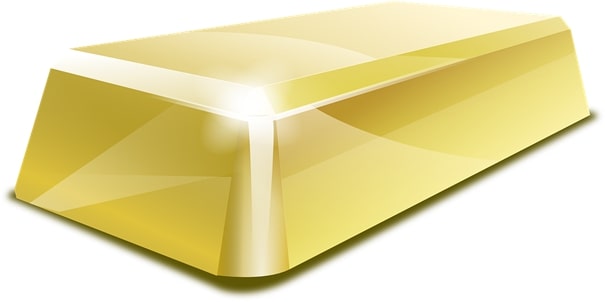How to invest in gold
Interested in buying gold? Read our guide to find out how to invest in gold. While the argument that gold and equities move in opposite directions is questionable, there’s no doubt that gold has proven itself time and time again as a viable insurance policy against a crisis. For that reason, it could be a great opportunity to learn how to invest in gold. With the turbulence in the financial markets so far in 2020, many investors are understandably seeking alternative investments. The idea is not to abandon stocks altogether, but rather to find other asset classes that can represent a sustainable counterweight. Here is our guide to investing in gold.
How to invest in gold (and where to buy it)
You don’t have to buy gold jewelry or 400-ounce gold bars to own the precious metal. Here are some of the best ways to invest in gold. Buy gold-backed ETFs Buy gold ETNs Buy physical gold bars Buy jewelry or collectible coins Buy shares of gold-producing companies Buy gold futures options Buy gold CFDs
1. buy gold funds
If exchange-traded funds (ETFs) are the most convenient way to invest in stocks, the same can be said of gold. Just like a stock-based ETF, a gold ETF represents physical gold in which you buy shares. ETFs can be traded like stocks and have the advantage that most major investment brokers have waived their trading fees on ETFs. And because it converts a physical asset into a digital one, it can easily be held in your portfolio alongside other assets. ETFs are the best way for beginners to invest in gold. They can be bought and sold through most major investment brokers, such as Nordnet, Aktieinvest and Avanzawhich are some of our favorites. A gold fund has the advantage of having indirect ownership of physical gold, which is less risky than other options. The largest gold ETFs are SPDR Gold Shares (GLD) and iShares Gold Trust (IAU), although there are others. However, none of these are allowed to be bought by European investors because of the regulatory framework known as MiFID II. The regulations do, however, allow Europeans to trade CFDs on US ETFs. However, there are a couple of European ETFs that offer exposure to gold, such as The Royal Mint Physical Gold ETC Securities (RMAU). This exchange-traded fund is created by the British company HanETF together with the British mint, The Royal Mint. It is the first fund to hold its gold with a European mint. It is called ETC and not ETF because it is a fund that offers exposure to physical commodities, all else being equal, it is an exchange-traded fund.
2. Buy ETNs with exposure to gold – Exchange Traded Certificates
Exchange-traded notes (ETNs) are debt instruments linked to an underlying investment. In the case of gold ETNs, the underlying investment is – you guessed it – gold. You will hold a certificate for a certain period of time and when it matures, you are paid based on the performance of the underlying gold. However, you can buy and sell these instruments during the term, hence the name. It is important to understand that gold ETNs are not a direct investment in gold but rather gold-related instruments. They can be held as either long or short positions and carry the possibility of losing some or all of your investment. For that reason, they are not recommended for anyone who is not well versed in the gold industry. Examples of gold ETNs include the UBS ETRACS CMCI Gold Total Return ETN (UBG) and the DB Gold Double Short ETN (DZZ).
3. Buy physical gold bars
You can buy gold and other precious metals in either coin or bar form. In both cases, you pay the per-ounce price of gold plus a small fee charged by the seller. Bars come in a wide range of sizes, from one gram (about 1/31 oz) to 400 oz. They have a lower markup because there is no minting involved. Wealthy investors buy larger bars when they don’t want a large number of coins. Coins have the advantage of being both recognizable and portable. That generally makes them easier to sell them. The most common gold coins are the American Eagle, the Canadian Maple Leaf and the South African Krugerrand, but of these three, only the Maple Leaf is pure gold. And there are many other coins available. Coins commonly come in the weights of one-tenth, one-quarter, half and one-ounce coins. But be aware that the lower denominations cost more per ounce than a coin weighing one ounce. Some coins can be alloyed with other metals. But each one-ounce coin contains a full ounce of gold. You can buy gold coins through local coin shops or well-established national dealers that handle all types of precious metals, such as Bullion Vault. You can either take possession of the coins yourself or have them stored by the dealer. If you choose to have them stored, you will pay both storage fees and insurance on an annual basis.
4. Buy jewelry or collectible coins
There are two types of gold coins you can buy: bullion coins – which we just discussed – and numismatic (collector) coins. Bullion coins are so called because their value is based entirely on the metal content of the coin. Numismatic coins may have an equivalent amount of gold, but their value comes mainly from the rarity of the coin. After gold coins became illegal in the United States in 1933, the government recalled millions of gold coins from circulation and melted them down to store the gold. As a result, pre-1933 US gold coins – and those of other countries – have become rare. So their numismatic value has increased. The rarer a coin is, the more value it has. For example, an extremely rare gold coin can have a value hundreds of times higher than its gold value. You can choose to own gold in a numismatic form. But understand that numismatics is more closely related to art than gold. Many people in developing countries own gold through jewelry. But most jewelry does not have investment value. For one thing, most jewelry made in the world is 14 carats of gold. That means the metal is only about 60 percent gold – the rest is alloys. Second, jewelry has very high manufacturing costs. You can pay $1000 for a piece of jewelry that contains no more than $100 of gold. Buy jewelry if you like it but don’t look at it as an investment.
5. Buy shares in gold mines
Shares in gold-producing companies are not a direct investment in gold, but rather in companies that mine gold. They tend to be much less consistent in value than gold itself, largely because they are subject to all the other factors that determine the value of any stock. But gold stocks have specific problems that make them even more volatile than most other stocks. Mining companies tend to operate in remote and often unstable regions of the world. Gold mining itself is capital-intensive and declines in the price of gold can cause a company’s shares to fall. For this reason, this type of stock is pure speculation. They are mostly a bet on rising gold prices. But in almost any other market cycle, they tend to be a bad investment. If you want to invest in gold-producing companies – and if you do, it should be with a very small part of your portfolio – a good choice might be to do so through gold mining funds. Two of the most popular are the VanEck Vectors Gold Miners ETF (GDX ) and the Fidelity Select Gold Portfolio (FSAGX). Each represents a portfolio of gold-producing companies. This provides diversification in an otherwise unpredictable industry. However, none of these funds is open to European investors and we have not found an equivalent in Europe.
6. buy gold futures
This is a way to take a position in gold with leverage. It is an advanced trading technique, so is only recommended if you know the gold market well. In a futures contract, you make an agreement to either buy or sell a certain amount of gold at a predetermined future date and price. The contract value will vary with the price of gold, and much as is the case with gold ETNs, there is an excellent chance of losing some or all of your investment, especially due to the leverage factor. For example, you can enter an option to buy gold at $1,800 per ounce by September 15. That way, you only put up 20 percent of the cost of the gold. If the price of gold rises 20 percent above $1,800, you have doubled your capital. But if it falls by 20 percent, you lose your entire investment.
7. Buy gold with a CFD
Much of what has been said about futures contracts above also applies to CFDs. The big difference is that with a CFD you can invest a smaller amount than with a futures contract. A CFD helps democratize the gold market and makes it accessible to almost all types of investors.
Gold and your investment strategy and portfolio
Given that gold doesn’t pay dividends or interest and doesn’t perform particularly well during times of prosperity and stability, it’s hard to make an argument for holding it as in all-weather investment. But it does have a demonstrated value during periods of crisis, as 2020 seems to be shaping up. Whatever your approach to investing in gold, keep your portfolio allocation to a minimum. A 10 per cent allocation is likely to be the most you need. It won’t make you rich – certainly not in the way that stocks can – but it can act as something of portfolio insurance. That’s because gold can come as close to being a countercyclical investment as there is. Just be careful not to assume there’s something magical about gold. It’s an ancient monetary asset that has a way of shining brightly at times when more modern financial instruments seem less secure. For that reason, you should think of it primarily as a defensive asset holding and little more.
Should you invest in physical gold?
While physical gold can be a way to diversify and can provide you with a solid, tangible asset that can help when times get tough (or if you think it’s only a matter of time before the US dollar is completely worthless), it’s important to think through your decision. As with any investment, it’s important to consider the downsides of investing in physical gold:
Where should you store your gold?
If you’re investing in physical gold, you need to figure out where to store it. Do you have a large safe at home where you can store your collection of gold coins? Maybe you keep your gold in a safe deposit box at the bank. In either case, your gold is vulnerable to theft. You may not be able to store your gold yourself. Some people prefer to use pooled accounts to help them store their physical gold. Your gold is in a vault, and you either have a numbered bar or coin specifically yours (allocated), or you have an amount of gold allocated to you (unallocated). With an allocated account, you usually have to pay a storage fee and an insurance fee. With an unallocated account, you don’t have to pay as many fees, but the gold may remain in the company’s name, creating a risk for you if the company goes bankrupt and the creditors get the gold. When you store gold on site, you have quick access to it, but it may be more vulnerable to disaster and theft. Store it off-site, however, and you may not be able to access it when you want it.
What will you use the gold for?
Many people consider gold to be ‘pure money’. After all, it has been used as a medium of exchange for thousands of years. As a result, it’s tempting to buy physical gold in an attempt to protect yourself against economic collapse. But if there is an economic collapse, who will accept your gold as money? If the system breaks down, gold will not be useful as barter. You can’t eat gold or use it for clothing or protection. Who will accept your gold and share their survival items? In such situations, gold is just not as valuable as you might think.
Premiums and taxes
Another issue with physical gold is that you have to take into account premiums and taxes. Usually, when you buy physical gold, you pay a premium, which means that the price exceeds the market price. The premium is usually smaller with pooled accounts, but it still exists. This means that if gold loses its value (maybe it’s a bubble that will burst), not only will you see that loss, but the premium you paid when you bought it will add to your losses. Keep in mind that gold is taxed. Right now, that means you pay a capital gains tax if you decide to sell your gold at a profit. If you buy gold shares, however, you will pay the ‘regular’ capital gains.
How well does gold hold its value in a downturn?
The answer to this question gets to the root of why anyone would want to invest in gold. Since 1970, the price of gold has risen by almost 4800%. In contrast, the stock market as measured by the S&P 500 index in 1970 at 90. It currently stands at around 3,000, for a cumulative gain of more than 3,300%. Regardless of how gold performs during stock market downturns, the price of gold has easily outperformed stocks over the past 50 years. During the 2007 financial crisis, the value of stocks, as measured by the S&P 500, dropped from 1,244 on January 1, 2007 to 1,123 on January 1, 2010. That’s a 21% decline over three calendar years covering the worst period. But over the same time, gold increased from about $630 per ounce on January 1, 2007 to $1,078 on January 1, 2010. This is a 71% increase over a three-year period compared to a 21% decline in the stock market. However, it is important to realize that the prices of gold and stocks do not necessarily move in opposite directions. The price of gold seems more closely correlated with broader global events than with the stock market. For example, the stock market lost more than 40% of its value peak-to-valley during the dot-com bubble of 2000-20002. During the same time, the value of gold remained relatively flat, rising by 10%. And in the decade of the 1970s, when inflation was destroying the United States, the price of gold increased by more than 1 800%, while stocks were largely unchanged. Gold was an excellent portfolio choice during turbulent times.
Why is gold valuable?
There are several answers to why gold is valuable. The first is the attractiveness of the metal itself. Pure gold has a brilliant luster and is incredibly durable. It doesn’t rust or oxidize like other metals do, nor is it subject to tarnishing. These qualities, along with its rarity, make it popular in the manufacture of jewelry, ornaments, commemorative medals (as in the Olympics) and building decoration. Gold is no longer priced at a fixed currency amount in each country. The price of gold is determined on commodity exchanges such as the London Bullion Market Association (LBMA) and Comex in New York. The LBMA meets twice a day to set the price at which member banks should buy gold bars. The price is determined by supply and demand for the metal each day. If demand exceeds supply, the price increases. But if supply exceeds demand, it decreases. However, because gold is an active commodity around the world, its price is negotiated in transactions between individuals and companies. For example, in times of high demand for gold, a gold trader will charge a higher price on the gold price than it would when there is less demand.
Where does the demand for gold come from?
In addition to demand for gold in lump form, the metal has significant industrial uses. According to the U.S. Geological Survey, 50% of gold is used in the manufacture of jewellery, 37% in electricity and electronics, 8% for official coins and 5% for “other” purposes. However, one of the biggest sources of demand for gold is from global central banks. They have been buying record amounts of gold in recent years, led by Russia and China. As central banks are the largest holders of gold in the world, their influence on the gold market cannot be overstated. Some of these central banks are stockpiling gold to reduce their dependence on the US dollar as a reserve asset. This trend is expected to continue for the foreseeable future. If so, it will have a positive impact on both the demand for gold and its price.
About the Vikingen
With Vikingen’s signals, you have a good chance of finding the winners and selling in time. There are many securities. With Vikingen’s autopilots or tables, you can sort out the most interesting ETFs, stocks, options, warrants, funds, and so on. Vikingen is one of Sweden’s oldest equity research programs.
Click here to see what Vikingen offers: Detailed comparison – Stock market program for those who want to get even richer (vikingen.se)













